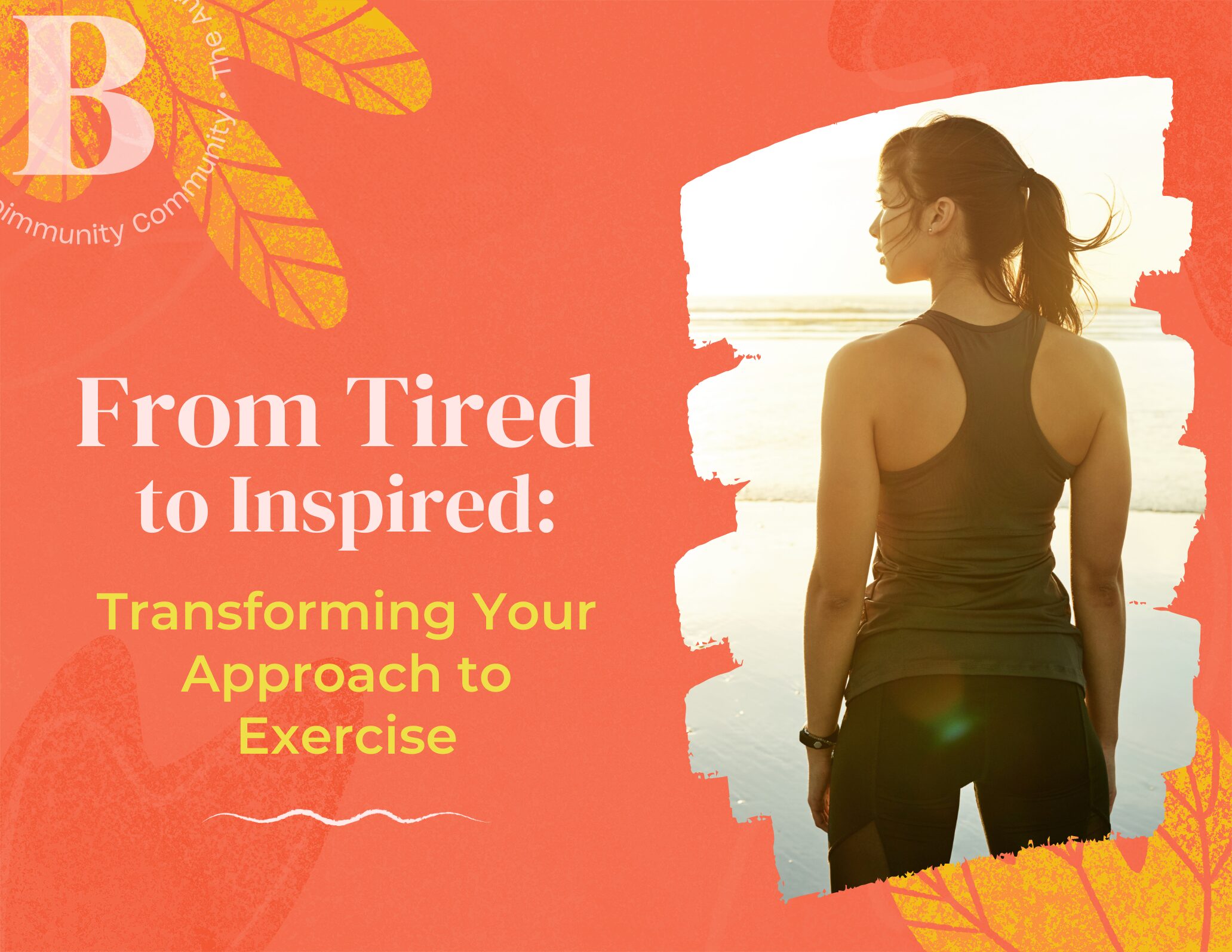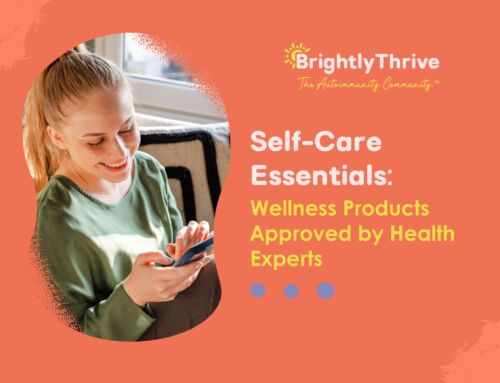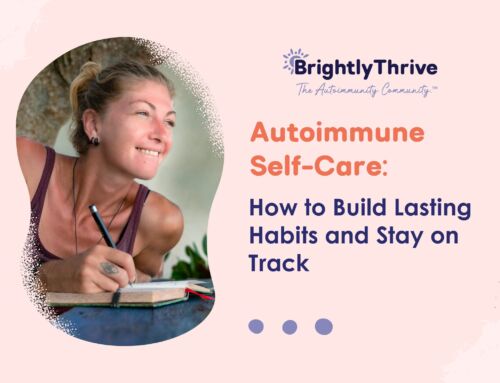
From Tired to Inspired: Transforming Your Approach to Exercise
Have you ever finished a workout feeling more exhausted than invigorated? You’re not alone.
Many people with autoimmune conditions question the belief that exercise always boosts energy. The truth is, exercise can sometimes leave you feeling drained if not approached correctly.
In this blog, we’ll try to understand why exercise can feel tiring and how we can transform your approach to make it inspiring. We’ll cover the right type and amount of exercise for your body, the importance of rest and recovery, and how to find a routine that energizes even our autoimmune bodies.
The Myth of Exercise as an Energy Booster
Conventional Wisdom vs. Reality
Fitness gurus and health enthusiasts often promise that a daily workout will leave you feeling like you can conquer the world. This belief is so ingrained that we assume exercise equals energy.
However, reality has a funny way of showing up uninvited. While exercise does offer numerous benefits like improved cardiovascular health, better moods (thanks, endorphins!), and weight management, its effect on energy levels can be as unpredictable as a cat on caffeine. Some folks finish a workout ready to take on anything, while others need a nap just from thinking about it.
Why Exercise Doesn’t Work the Same for Everyone
Understanding why exercise isn’t a one-size-fits-all energy booster requires a look at individual physiology, fitness levels, and personal circumstances.
- Individual Physiology: Each body is unique, reacting differently to physical exertion. Metabolism, muscle composition, and hormonal balance all play roles. Some people are like solar panels, converting exercise into energy efficiently. Others are more like old batteries, losing steam quickly.
- Fitness Levels: Your current fitness level also matters. Beginners might find themselves exhausted from even moderate exercise because their bodies aren’t used to the effort. As fitness improves, so does energy efficiency. But even fitness fanatics can overdo it and end up as tired as a parent after a toddler’s birthday party.
- Personal Circumstances: Lifestyle factors such as sleep, nutrition, stress, and overall health significantly impact how exercise affects you. If you’re sleep-deprived or stressed out, exercise might just add to your fatigue. However, with a balanced diet, good stress management, and plenty of rest, exercise can become your secret weapon for energy.
- Type and Intensity of Exercise: Not all exercises are created equal. High-intensity workouts might leave you feeling like you’ve been run over by a truck if done too often without proper recovery. Meanwhile, low to moderate-intensity activities like walking, yoga, or light cycling can help maintain energy levels. It’s all about finding the Goldilocks zone of exercise that’s “just right” for you.
- Psychological Factors: Your mental approach to exercise matters too. If working out feels like a chore or an obligation, it can be mentally draining, leaving you feeling more tired. But if you see physical activity as a form of self-care or enjoyment, it can be rejuvenating. Remember, it’s not a prison sentence—it’s your body’s way of having fun.
Identifying the Causes of Exercise-Induced Fatigue
Ever feel like you’re dragging a sack of potatoes behind you during your workout? Or that the treadmill suddenly turned into a conveyor belt to nowhere? Let’s break down why you might be feeling more tired than inspired and how to get back on track.
Overexertion and Its Impact on Physical and Mental Energy
We’ve all been there: you hit the gym hard, trying to channel your inner superhero, but instead, you end up feeling like you’ve been run over by a bus.
Overexertion isn’t just a fancy word for working too hard—it’s your body’s way of saying, “Whoa, slow down there, champ!”
When you push yourself beyond your limits, both physically and mentally, it can lead to a significant dip in energy levels. It’s like trying to run your car on fumes; eventually, it’s going to sputter and stop. So, remember, even superheroes need a day off!
Importance of Proper Nutrition and Fuel
Think of your body as a high-performance machine. Would you fill a sports car with cheap fuel and expect it to win races? Of course not!
The same goes for your body. Proper nutrition is the high-octane fuel you need to keep your engine running smoothly.
Skip the junk food and opt for balanced meals rich in protein, healthy fats, and complex carbs.
And don’t forget to hydrate! Water is the unsung hero of energy levels, so keep that bottle handy. Because, let’s face it, nobody ever set a personal best while being hangry.
The Role of Sleep in Recovery and Energy Levels
Ah, sleep. The magical elixir of life. Yet, we often treat it like an optional luxury. Newsflash: it’s not!
Quality sleep is crucial for recovery and maintaining energy levels. Skimp on sleep, and you’re basically signing up for a zombie workout.
And not the fun, dance-with-Michael-Jackson kind of zombie—more like the dragging-your-feet, can’t-lift-a-weight kind.
Aim for those golden 7-9 hours of sleep per night. Your muscles (and your mood) will thank you.
Stress and Its Effects on the Body
Stress is like that annoying person who shows up uninvited and overstays their welcome. When stress takes hold, it wreaks havoc on your body, making you feel tired and run down.
Cortisol, the stress hormone, is great in small doses but can drain your energy when it’s constantly elevated.
Incorporate stress-busting activities into your routine, like yoga, meditation, or even just a good laugh with friends. Because, honestly, sometimes the best workout is a belly laugh.
Hormonal Fluctuations and Their Impact on Energy
Hormones are the body’s little messengers, running around and making sure everything works smoothly. But when they’re out of whack, it’s like a miscommunication in a game of telephone—everything gets mixed up.
Hormonal fluctuations, especially in women, can lead to unpredictable energy levels. It’s not in your head; it’s science.
If you’re feeling unusually tired, it might be worth discussing with a healthcare professional. And no, you’re not just being dramatic—blame it on the hormones!
Chronic Illnesses and Their Overlooked Effects in Fitness
Chronic illnesses can be the stealth ninjas of the fitness world, silently sapping your energy without you even realizing it.
Conditions like thyroid disorders, diabetes, or autoimmune diseases can seriously impact your ability to exercise. It’s essential to listen to your body and work with healthcare professionals to manage these conditions.
Don’t let a chronic illness make you feel like a failure in your fitness journey. Instead, celebrate the small victories and remember that even small steps can lead to big progress.
4 Practical Strategies to Improve Your Exercise Experience
1. Tailoring Exercise to Your Current Fitness Level
Let’s face it: jumping straight into an advanced workout can feel like trying to climb Mount Everest in flip-flops. Instead, start where you are.
If your current fitness level involves more couch potato than marathon runner, that’s okay! Gradually increase your intensity, and remember, even small steps can lead to big changes.
Think of it as leveling up in a video game—start at Level 1, and before you know it, you’ll be a fitness warrior.
2. Importance of Pacing and Rest Intervals
Rome wasn’t built in a day, and neither is a fit body. Pacing yourself during workouts is crucial. Mix in rest intervals to catch your breath and let your muscles recover.
Keep it steady, and remember, rest is part of the process, not a sign of weakness.
3. Expanding Your Definition of Exercise to Include Gentle Movements
Who says exercise has to be all sweat and no fun? Expand your definition to include gentle movements like yoga, tai chi, or even a leisurely walk with your dog.
Picture this: you’re not just exercising; you’re practicing mindful movement, giving your body and mind a much-needed break.
Plus, it’s a great excuse to bust out those yoga pants for something other than Netflix binges.
4. Utilizing Props for Accessibility and Efficiency
Props aren’t just for theater; they can be game-changers in your fitness routine. Resistance bands, stability balls, and even a good old-fashioned chair can make exercises more accessible and efficient.
Also, incorporating props can make exercises easier on your joints while still giving you a killer workout.
So, grab that resistance band and channel your inner superhero—because who doesn’t want to feel like Wonder Woman while working out?
4 Ways to Develop a Sustainable and Personalized Exercise Routine
1. Checking in with Your Body Before and During Exercise
Listen, your body isn’t a machine, and even if it were, it would still need regular maintenance! Before diving into your workout, take a moment to check in with yourself.
- How are you feeling?
- Energized or exhausted?
- Ready to conquer the world or barely able to conquer your bed?
By tuning into your body’s signals, you can tailor your workout to what you actually need that day. Remember, even superheroes need a day off to recharge their powers.
2. Balancing Intensity with Recovery
Ever heard the saying, “All work and no play makes Jack a dull boy”?
Well, all intensity and no recovery make Jack a sore boy!
It’s important to balance high-intensity workouts with adequate recovery. Think of recovery days as the sweet dessert after a hearty meal; they’re essential for keeping you happy and motivated.
So go ahead, treat yourself to that rest day – your muscles will thank you.
3. Integrating Diverse Types of Movement
Variety is the spice of life, and it’s also the secret ingredient to a sustainable exercise routine.
Don’t let your workouts become as monotonous as a rerun of your least favorite TV show.
Mix it up with different types of movement – try yoga, dancing, hiking, or even a fun game of dodgeball.
Not only will this keep things interesting, but it will also work different muscle groups and keep your body guessing.
4. Embracing a Holistic Approach to Fitness
Fitness isn’t just about sweating buckets in the gym; it’s about nurturing your entire well-being.
Embrace a holistic approach by incorporating mindfulness, nutrition, and mental health into your routine.
Think of it as building a well-rounded character in a video game – you want to level up all your skills, not just one.
By focusing on your overall health, you’ll find a sustainable path to staying fit and fabulous.
Final Thoughts
Transforming your approach to exercise isn’t about conquering mountains on day one; it’s about finding joy in the journey.
Remember, the aim is to go from feeling like a tired sloth to an inspired gazelle—graceful and full of energy (minus the grass diet).
Now, it’s your turn. Take the reins of your fitness journey and make it uniquely yours. Don’t be afraid to try new things, laugh at the mishaps, and celebrate the small victories. As they say, “The only bad workout is the one that didn’t happen.”

Ready to take your relationship with exercise to the next level? Join the BrightlyThrive community and connect with others who are transforming their approach to exercise, as well. Download the BrightlyThrive app today and start your journey towards a healthier, happier you! 🚀💪
References
Cristian. (2022, August 21). Exercise Makes Me Tired Not Energized: 7 Reasons You Crash After Training. ENutritionReads.com. https://enutritionreads.com/articles/exercise-makes-me-tired-not-energized/
Reynolds, G. (2022, January 19). How to build healthy habits. The New York Times. https://www.nytimes.com/2022/01/19/well/move/habits-motivation-exercise.html
Pinckard, K., Baskin, K. K., & Stanford, K. I. (2019). Effects of Exercise to Improve Cardiovascular Health. Frontiers in Cardiovascular Medicine, 6. https://doi.org/10.3389/fcvm.2019.00069
Christianson, A. (2022, November 22). How Exercise Increases Your Energy Levels. Dr. Alan Christianson. https://www.drchristianson.com/blog/how-exercise-increases-your-energy-levels/
Royal College of General Practitioners, & Royal College of Nursing. (2020). Physical activity and exercise for immune function. Retrieved from https://www.rcgp.org.uk/getmedia/e500d126-0419-479f-b99b-217d19b1c7e9/RCGPRCNCSPBasemM2MFactsheetPAExerciseImmuneFunction0820FINAL.pdf
Vlce, K. a. M. C. (2023, January 3). Is High-Intensity Exercise Always Best? Real Simple. https://www.realsimple.com/health/fitness-exercise/exercise-intensity
How to Stop Making Exercise Feel Like A Chore. (2022, November 17). Five Star Wellbeing. https://fivestarwellbeing.com/stop-making-exercise-a-chore/
Kamona, N. (2023, May 18). Don’t Ignore Your Recovery: What Happens When You Push Yourself Too Far — ONVY — ONVY. ONVY. https://www.onvy.health/blog/k6trrtv0uy0u0jc1ysokg95orxh6ee
Food as Fuel Before, During and After Workouts. (2023, December 18). www.heart.org. https://www.heart.org/en/healthy-living/healthy-eating/eat-smart/nutrition-basics/food-as-fuel-before-during-and-after-workouts/
Summer, J., & Summer, J. (2024, February 29). 8 Health Benefits of Sleep. Sleep Foundation. https://www.sleepfoundation.org/how-sleep-works/benefits-of-sleep
Life’s Essential 8 – How to Get Healthy Sleep Fact Sheet. (n.d.). www.heart.org. https://www.heart.org/en/healthy-living/healthy-lifestyle/lifes-essential-8/how-to-get-healthy-sleep-fact-sheet
Sparks, D. (2021, July 12). Chronic stress can wreak havoc on your mind and body. Mayo Clinic News Network. https://newsnetwork.mayoclinic.org/discussion/chronic-stress-can-wreak-havoc-on-your-mind-and-body/
Dellwo, A. (2021, November 23). What Is Cortisol? Verywell Health. https://www.verywellhealth.com/cortisol-what-it-is-its-functions-associated-conditions-5208916
Hormonal Imbalance in Women: 9 Signs to Look For. (2022, February 11). Flo.health – #1 mobile product for women’s health.
https://flo.health/menstrual-cycle/health/symptoms-and-diseases/hormonal-imbalance-in-women
Ace-Cpt, L. J. (2021, November 30). How to Begin Working Out With a Chronic Illness. Verywell Fit. https://www.verywellfit.com/how-to-begin-working-out-with-a-chronic-illness-5209259
Jeff, C., & Jeff, C. (2021, December 26). Rest Periods During Workouts – An Overlooked Element of Training – Runners Connect. Runners Connect -. https://runnersconnect.net/rest-element-of-track-workouts/
ZOE. (n.d.). Physical activity examples. ZOE. Retrieved May 28, 2024, from https://zoe.com/learn/physical-activity-examples
Ezrin, S., & Ezrin, S. (2021, November 12). Why Everyone (Including You) Should Use Props in Their Yoga Practice. Yoga Journal. https://www.yogajournal.com/practice/why-everyone-should-use-yoga-props/
Ms, E. Q. (2022, December 16). Why You Need Rest and Recovery After Exercise. Verywell Fit. https://www.verywellfit.com/the-benefits-of-rest-and-recovery-after-exercise-3120575
Digest, Y. (2023, April 5). How to Build a Sustainable Exercise Routine That Fits Your Lifestyle | Yoga Digest. Yoga Digest. https://yogadigest.com/how-to-build-a-sustainable-exercise-routine-that-fits-your-lifestyle/
Mindfulness for Your Health. (2022, July 15). NIH News in Health. https://newsinhealth.nih.gov/2021/06/mindfulness-your-health
CPT, L. G. (2021, May 7). How to Build a Sustainable Workout Routine: 10 Tips That Will Help You Exercise Consistently. SELF. https://www.self.com/story/fitness-resistance-building-sustainable-workout-program
TAGS:
CATEGORIES:












